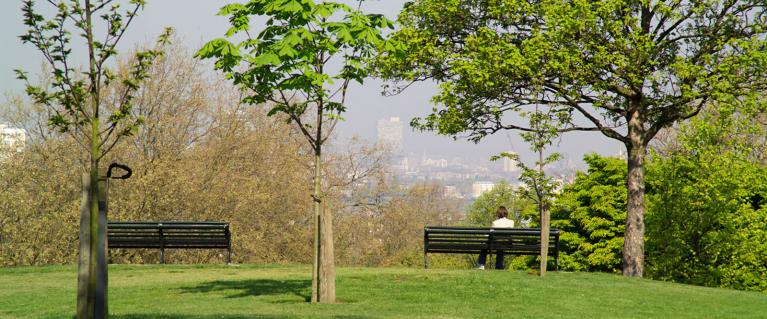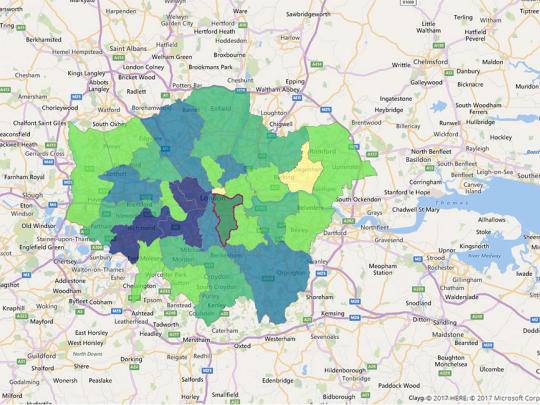
Natural capital account for London
A groundbreaking study published in November 2017 shows - for the first time - the economic value of health benefits that Londoners get from the capital's public parks and green spaces.
What is natural capital?
'Natural' capital is made up of the elements of nature that benefit people directly or indirectly. These assets include ecosystems, species, fresh water, land, minerals, the air and oceans, as well as natural processes and functions. Benefits can include goods (such as timber and food) and services (such as clean air and water).
In an urban context, these assets are our parks, rivers, trees, and features such as green roofs that collectively form an essential green infrastructure. Designed and managed as green infrastructure, natural capital can:
- promote healthier living
- lessen the impacts of climate change
- improve air quality and water quality
- encourage walking and cycling
- store carbon
- improve biodiversity and ecological resilience
A natural capital account can help to inform and improve decision-making by framing public green spaces as economic assets, and highlighting the range and value of benefits that they provide. This approach is supported by a national and London policy framework.
Public green spaces are essential for maintaining a good quality of life, especially in urban areas. Protecting our natural heritage and public green spaces for sport and recreation is a cornerstone of city planning policy.
All London boroughs maintain a network of public green spaces, even though this is a discretionary service rather than a statutory duty.
Public sector funding constraints mean all local authorities need to cut costs. The impact of this has been investigated and summarised in the State of UK Public Parks 2016 report (PDF) published by the Heritage Lottery Fund.
Reducing funding for parks and green spaces is a false economy
- London’s public green spaces have a gross asset value of more than £91 billion, providing services valued at £5 billion per year
- for each £1 spent by local authorities and their partners on public green space, Londoners enjoy at least £27 in value
- Londoners avoid £950 million per year in health costs due to public green space
- the value of recreational activities is estimated to be £926 million per year
- for the average household in London, the monetary value of being in close proximity to a green space is over £900 per year
Public green spaces offer other services too, such as temperature regulation and carbon storage. Green spaces in urban areas counter higher temperatures in summer months that can lead to ill health.
The economic benefits are not spread equally across or within London boroughs. The account also indicates that there is a fairness and equality agenda that must be addressed in future funding and investment.
London boroughs face significant budgetary constraints while the demand for the services they must provide is increasing.
The boroughs, and other owners and managers of public green space, have made cost savings and implemented other efficiencies (such as shared services) to address tighter budgets. However, more needs to be done to reorganise the ‘parks service’ as local authorities and their partners prioritise their statutory obligations.
The Mayor has set out the ways in which he, in partnership with others, intends to help.
Promoting the natural capital accounting approach
The Government has committed to including natural capital accounts in the UK Environmental accounts by 2020. This means natural capital accounts can be used alongside other key indicators of economic performance.
The Natural Capital Committee has flagged the development of natural capital accounts as a signal to decision-makers that monitoring and valuing natural assets is important. The Office for National Statistics has been charged by Government to develop a roadmap to enable this. They have also produced a natural capital overview of the work towards this objective.
This natural capital account for London’s public green spaces report contributes to this work by showing that natural capital accounting makes sense in an urban context and can be applied effectively to urban green infrastructure.
Establishing a London Green Spaces Commission
The Mayor will establish a Green Space Commission to work with London boroughs to explore more sustainable ways of managing their parks and green space services. The Commission will:
- promote the socio-economic value of London’s public green space asset as a coherent and functioning infrastructure for London (for example, promoting the London Natural Capital Account)
- examine the existing model of service delivery for public green spaces; highlight innovative thinking about the purpose and function of public green space; and, propose alternative approaches
- determine the most suitable future models to secure long-term funding and investment for London’s public green spaces
The London Green Spaces Commission will expand upon and provide a London focus to initiatives such as Future Parks and Rethinking Parks.
Influencing Government policy
The Government has established a Parks Action Group following the public parks inquiry by the Communities and Local Government Select Committee. The group will make proposals to address some of the issues faced by public parks across England.
The Mayor expects his Green Spaces Commission will work closely with the Parks Action Group to ensure the best ideas and proposals are brought forward to protect public green spaces in an increasingly urbanised population.
The Mayor will also lobby around key proposals and initiatives in the Government’s upcoming 25 Year Environment Plan. He wants to make sure that enough support and resources are available to invest in public green spaces – an asset base that will help cities with the social and environmental challenges they face.
Making London a National Park City
The natural capital account demonstrates that London’s green spaces are a highly valuable asset, and investment in them provides good value for money. We know also that Londoners appreciate and demand good quality green space.
London is set to be home to over 11 million people by 2050. We will have to adapt and innovate policy, practice and the way in which we make investment decisions, to ensure we maintain and improve London’s public green space.
London as a National Park City provides an opportunity to promote why and how a more integrated approach to the planning, design and delivery of a ‘green infrastructure’ works to bring the economic, social and environmental benefits the city and Londoners need. It will also help individuals, communities, businesses and institutions appreciate their potential to contribute to making London a greener, more resilient city.
Natural capital accounts by borough
Download Borough Natural Capital Accounts
Download Natural capital account methodology
Need a document on this page in an accessible format?
If you use assistive technology (such as a screen reader) and need a version of a PDF or other document on this page in a more accessible format, please get in touch via our online form and tell us which format you need.
It will also help us if you tell us which assistive technology you use. We’ll consider your request and get back to you in 5 working days.


